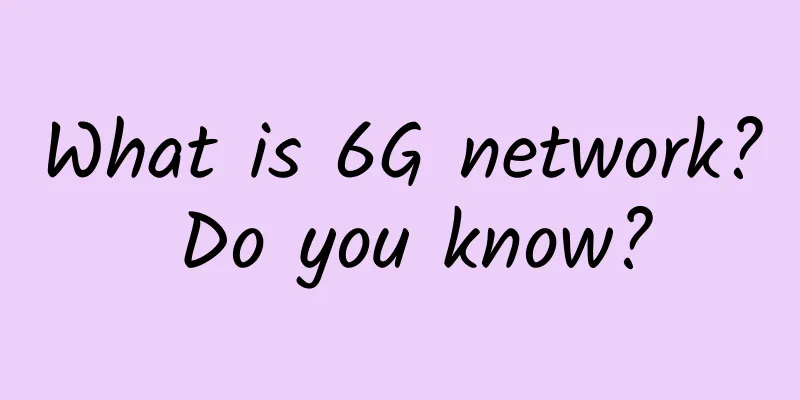What is 6G network? Do you know?

|
6G networks are defined as cellular networks that operate at untapped radio frequencies and use cognitive technologies such as AI to enable high-speed, low-latency communications at speeds several times faster than fifth-generation networks. This article discusses 6G, the next generation of cellular data networks. It also explains the core features of 6G and how it works. What is 6G network?6G networks are defined as cellular networks that operate at untapped radio frequencies and use cognitive technologies such as artificial intelligence to enable high-speed, low-latency communications at speeds several times faster. 6G networks are currently under development and have not yet been released. 6G is the sixth-generation mobile system standard currently under development for wireless communications on cellular data networks in telecommunications. It is the successor to 5G, or the next turning point on the road, and may come much faster. The International Telecommunication Union standardizes wireless generations every ten years. Usually, they are represented by a gap in the "air interface", which means a shift in transmission or coding. This is so that old equipment cannot be updated to a new generation, because doing so would generate an unlimited amount of "noise" and "spectrum pollution". Typically, the next generation uses more complex digital coding that outdated computers can't implement. They rely on wider wireless bands that governments haven't made available before. In addition, they have very complex antenna arrays that were impossible to build before. Today, we are already at the fifth generation. The first standards for 5G New Radio (NR) were developed in 2017 and are now being implemented around the world. How will 6G work?Exactly how 6G will work is still unclear, as the specifications have yet to be fully developed, finalized, and published by the ITU. However, one can expect several core features that rely on previous generations of cellular networks. 6G will primarily operate in the following ways: Leveraging free spectrum: A large part of 6G research is focused on transmitting data at ultra-high frequencies. In theory, 5G can support frequencies up to 100GHz, although frequencies above 39GHz are not currently used. For 6G, engineers are trying to transmit data on waves in the hundreds of gigahertz, or terahertz, range. These waves are tiny and fragile, but there is still a lot of unused spectrum that could enable amazing data speeds. Improving the efficiency of free spectrum: Current wireless technology allows transmission or reception on a specific frequency at the same time. For two-way communication, users can divide their streams according to frequency (frequency division duplex or FDD) or by defining time periods (time division duplex or TDD). 6G may improve the efficiency of current spectrum transmissions, using complex mathematical methods to transmit and receive simultaneously on the same frequency. Leveraging mesh networks: Mesh networks have been a hot topic for decades, but 5G networks are still largely based on a hub-and-spoke architecture. So end-user devices connect to anchor nodes, which connect to the backbone. 6G will likely use machines as amplifiers of each other's data, allowing each device to expand coverage while using data. In conjunction with 'New IP': A research paper from the 6G Flagship Program at the University of Oulu in Finland suggests that 6G may use a new variant of the Internet Protocol (IP). It compares current IP packets, either IPv4 or IPv6, to regular snail mail, complete with a labeled envelope and page of text. The 'New IP' packets would be comparable to fast-tracked courier packages delivered by courier services with navigation and priority information. 6G will rely on the selective use of different frequencies to assess absorption and adjust the wavelength appropriately. The technology will take advantage of the fact that atoms and molecules produce and absorb electromagnetic radiation at specific wavelengths, and the emission and absorption frequencies of any particular material are the same. When will 6G be available on the market?As mentioned earlier, the commercial debut of 6G internet is expected to come online around 2030-2035. In addition to the ITU, the Institute of Electrical and Electronics Engineers (IEEE), a non-profit technical standards association, approved this date in its peer-reviewed paper titled "6G Architecture to Connect the World." The document notes that 2030 and beyond will offer a unique set of challenges and opportunities of global relevance and scale to achieve a post-pandemic future communications architecture while enabling growth, sustainability and universal digital inclusion. While there have been some preliminary conversations to describe the technology, work on 6G officially began in 2020. The 6G Flagship initiative combines research into 6G technology across Europe. Japan has pledged $482 million for 6G expansion over the next few years. The country’s primary goal is to demonstrate innovative wireless and mobile technologies by 2025. Russia made a forecast in 2021 predicting the availability of 6G networks by 2035. US mobile operators are advancing their respective 6G innovation roadmaps. Importantly, AT&T, Verizon, and T-Mobile are leading the industry-first NextG Alliance. In May 2021, the NextG Alliance launched a technical work plan to develop 6G technologies. Why do we need 6G?Considering that 5G deployments have not fully penetrated and even 4G penetration in remote areas is low, one might ask why there is a need to make efforts in 6G. Its main focus is to support the fourth industrial revolution by building bridges between human, machine and environmental nodes. In addition to surpassing 5G, 6G will also have a series of unique capabilities that use machine learning (ML) and artificial intelligence (AI) to establish the next generation of wireless communication networks for connected devices. This will also benefit emerging technologies such as smart cities, driverless cars, virtual reality and augmented reality, as well as smartphone and mobile network users. It will combine and correlate different technologies, such as deep learning and big data analytics. A substantial correlation between 6G and high-performance computing has been observed. While some IoT and mobile data may be processed by edge computing resources, much of the data will require more centralized high-performance computing capabilities, making 6G an essential component. 8 unique features of 6G6G networks will likely coexist with 5G for some time and will be a significant improvement over previous generations in several ways. This is because 6G will offer the following different capabilities: 1. Use of new frequency bandsSpectrum is an essential component of radio connectivity. Each new generation of mobile devices requires a pioneer spectrum to fully exploit the advantages of any further technological advances. Restructuring the current digital cellular spectrum from legacy to next generation technologies will also be part of this transition. For urban outdoor cells, the latest pioneer spectrum board for 6G is expected to be in the mid-band 7-20GHz. This will provide greater capacity through extreme multiple-input multiple-output, low-band 460-694MHz for wide coverage, and sub-terahertz spectrum (between 90GHz and 300GHz) for peak data speeds exceeding 100Gbps. 5Gadvanced extends 5G beyond data transmission and significantly improves positioning accuracy to centimeter-level accuracy. The broad spectrum used by 6G, including new spectrum ranges up to terahertz, will push positioning to the next level. 2. Extremely high data transmission speed5G plans to provide a peak data throughput of 20Gbps and a user-experienced data rate of 100Mbps. However, 6G will provide a maximum data rate of 1Tbps. Likewise, it will increase the user-experienced data rate to 1gbps. Therefore, the spectrum efficiency of 6G will be nearly twice that of 5G. Higher spectrum efficiency will provide instant modern multimedia services to many users. Network operators must redesign the existing infrastructure framework to achieve higher spectrum efficiency. 3. Ultra-low latency network functionThe latency of 5G will be reduced to 1 millisecond. The performance of many real-time applications will be enhanced by this ultra-low latency. However, the sixth generation of wireless communication technology will reduce the latency experienced by users to less than 0.1 milliseconds. Due to the significant reduction in latency, many latency-sensitive real-time applications will have better performance and functionality. Furthermore, reduced latency will allow for emergency response, remote surgical procedures, and industrial automation. In addition, 6G will make networks 100 times more reliable than 5G networks, facilitating seamless execution of latency-sensitive real-time applications. 4. Better support for machine-to-machine (M2M) connectionsWhile 5G addresses human users and Internet of Things (IoT) use cases, 6G will focus more on M2M connections. Today, 4G networks support about 100,000 devices per square kilometer. 5G technology is much more advanced and can connect 1 million devices per square kilometer. With the advent of 6G networks, the goal of 10 million connected devices per square kilometer is within reach. All 6G networks will include mobile edge computing, although it must be added to current 5G networks. By the time 6G networks are implemented, edge and core computing will be increasingly assimilated as elements of a unified communications and computing infrastructure framework. 5. Focus on energy efficiencyAs mentioned earlier, 6G networks will require stronger radio frequencies to meet the requirements of greater bandwidth. However, one of the challenges is that the underlying chip technology cannot currently operate efficiently in these frequency ranges. Therefore, optimizing power consumption will be a key area of focus for 6G developers. Currently, researchers intend to reduce energy consumption per bit to less than 1 nanojoule (10-9 joule). 6. Higher network reliabilityThe ultra-reliable low-latency communication (URLLC) services dominated by 5G will be further developed and enhanced in 6G. Reliability is likely to be enhanced through simultaneous transmission, a large number of wireless hops, device-to-device connectivity, and AI/ML. As a result, 6G will outperform 5G in terms of network penetration and stability. In addition, 6G will optimize M2M interactions by increasing network reliability by more than 100 times and reducing error rates by 10 times compared to previous generations. 7. The rise of new architecture5G is the first solution to replace wired connections in enterprise and industrial environments. It is deploying service-oriented architecture in core infrastructure and cloud-native deployments, and will be extended to parts of the radio access network (RAN). In addition, it is expected that 6G networks will be implemented in heterogeneous cloud settings, including a combination of private, public and hybrid clouds, with the right architecture to support this. 8. Use AI and ML for optimal connectivity5G will enable artificial intelligence (AI) and machine learning (ML) technologies to realize their full potential. Ultimately, AI/ML will be implemented in various network components, network levels, and network services. From beamforming refinement at the radio layer to planning at cell sites using self-optimizing networks, AI/ML will help achieve superior efficiency with reduced computational complexity. 6G developers, such as Nokia Bell Labs, hope to take a blank slate approach to AI/ML, allowing AI/ML to determine the best communication method between two endpoints. Advantages of 6G Networks6G networks are expected to provide the following benefits: 1. Enhance securityCyberattacks are increasingly focused on all types of networks. The complete unpredictability of these attacks requires the implementation of strong security solutions. 6G networks will have safeguards against threats such as jamming. Privacy issues must be addressed when creating new mixed reality environments. 2. Support personalizationOpenRAN is a new and evolving technology used by 5G. However, OpenRAN will be a mature technology for 6G. AI-based RAN will allow mobile network operators to provide users with a customized network experience based on real-time user data collected from multiple sources. Operators can further leverage real-time user data to provide better services through personalized Quality of Experience (QoE) and Quality of Service (QoS). Operators can use AI to customize multiple services. 3. Expand the functionality of 5G applicationsThis degree of bandwidth and responsiveness will enhance the performance of 5G applications. It will also expand the range of capabilities to enable new and innovative wireless networking, cognitive, monitoring and imaging applications. Using orthogonal frequency division multiple access (OFDMA), 6G access points will be able to serve multiple clients simultaneously. 4. Promote the development of wireless sensing technologyThe sampling rate refers to the number of samples obtained from a continuous signal per second (or in equivalent time units) to form a digital signal. The frequencies of 6G will allow faster sampling rates than 5G. In addition, they will provide significantly improved throughput and data rates. In addition, the utilization of submillimeter waves (wavelengths below 1 mm) and frequency selectivity are expected to accelerate the development of wireless sensing technology. The network will become a repository of contextual data by collecting signals reflected from objects and detecting their type, shape, relative position, speed, and possibly material quality. This sensing approach can facilitate the creation of a “mirror” or digital counterpart to the actual environment. When combined with AI/ML, this information will provide new insights into the physical world, making the network smarter. 5. Stimulate new technological innovation6G will benefit all of society as new technological innovations will support it. This includes: More advanced data centers: 6G networks will generate more data than 5G networks, and computing will evolve to ultimately include edge and core platform coordination. As a result of these changes, data centers will need to evolve. Nanocores replacing traditional processor cores: Nanocores are expected to evolve into single computing cores that combine HPC and AI. A nanocore is not necessarily a tangible network node. Instead, it may consist of a conceptual aggregation of computing resources shared by several networks and systems. 6. Save costs by reducing software dependenciesModern networks are already using software-defined operations. Other 6G components, such as the media access control (MAC) and physical (PHY) layers, will be virtualized. Currently, PHY and MAC solutions require the deployment of specialized network hardware. The virtualization provided by 6G will reduce the cost of network equipment. Therefore, very dense 6G deployments will be economically feasible. 7. Increase the penetration of cellular networksOne of the many advantages of 6G networks is their wide coverage area. This means that smaller towers are needed to cover a given space. This is useful if you want to build towers in places where it rains frequently or there are thick trees and vegetation. In addition, 6G is designed to support other mobile connections besides 5G. This means that there will be less interference between devices, thus improving service. 8. Optimize indoor network usageToday, most cellular traffic is generated indoors, yet cellular networks were never built to properly target indoor coverage. 6G overcomes these obstacles using femtocells (small cell sites) and distributed antenna systems (DAS). SummarizeEven as 5G continues to roll out around the world, leading research consortiums and mobile companies are busy working on the sixth generation of mobile connectivity. 6G networks are designed to connect the physical and virtual worlds through faster M2M communications and better support immersive technologies. Organizations should understand the working and importance of 6G networks to prepare for the future and make the most of the available wireless infrastructure. |
<<: What are the hot technologies in 2023?
Recommend
Ministry of Industry and Information Technology: Hangzhou Asian Games opening ceremony pioneered 5G ultra-dense networking solution, with seamless network coverage of venues
"Industry and Information Technology V News&...
Chrome DevTools: Modify User-Agent and customize personalized UA
[[442534]] This article is reprinted from the WeC...
Why are they so obsessed with Tencent? How hard do the relevant departments work to review apps before they are put on the shelves?
Yesterday, the news that "Tencent's apps...
This year's Internet Light Expo has upgraded its black technology: these new gadgets are quite cool
On November 6, the 5th World Internet Conference ...
Teach you a few tips to improve the security of wireless routers - no longer have to worry about freeloading
With the popularity of wireless networks, wireles...
HostUS: VPS in 7 data centers in Los Angeles starting at $16 per year, with optional OpenVZ/KVM architecture
HostUS has a low presence now, but it was very po...
Development Trends and Prospects of Future Networks
[[375296]] Recently, Liu Yunjie, academician of t...
Slow internet speed, lagging video conferences, these are the pain points of Wi-Fi for small and micro businesses. How to solve them?
Currently, online video conferencing has become a...
CloudCone New Year Promotion: $10.99/year KVM-512MB/20GB/2TB/Los Angeles Data Center
CloudCone has updated its 2023 promotional progra...
TCP source code analysis - three-way handshake Connect process
[[386167]] This article is reprinted from the WeC...
Five things you need to know before buying a router
A router is a digital product that basically no o...
CrownCloud: Los Angeles 1TB large hard drive VPS annual payment starts at $30, AMD Ryzen7950X series annual payment starts at $35
CrownCloud, which I first shared information abou...
Maxthon Hosting: 600 yuan/month Hong Kong Dedicated Server-E5-2630v2/16GB/480G SSD/2IP/CN2 GIA Line
The tribe has shared information about Aoyo Zhuji...
How to ensure consistency of Serverless business deployment updates?
Since I started working on Serverless tools, I of...
On "GPL is a trap for software developers"
[[381740]] This article is reprinted from the WeC...









